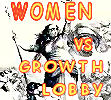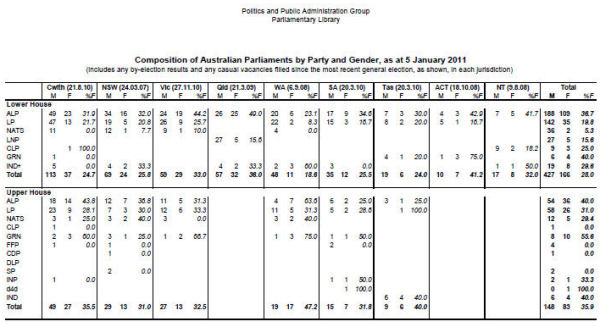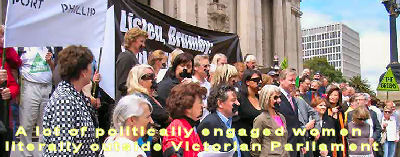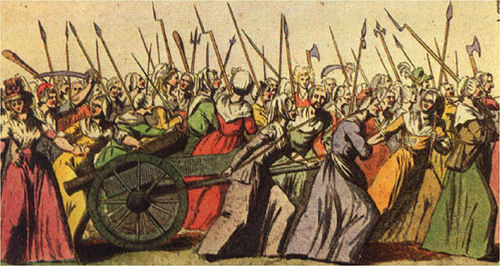 This article was adapted from a radio program I hosted on 3RPP with Jenny Warfe as my guest, called "Women in Politics, Why don't more participate?" The program found that participation rates depend on definition. Indeed, we found that women dominate politics in Victoria, Australia - they just don't draw salaries. Inside we look at three classical theories for why women participate less in politics than men; argue that the Real Politics are outside Parliament, (Indian theory); give examples of Victorian women in politics outside Melbourne's parliament; analyse these women's political roles as more reactive and militant than planned-for and careerist. We also note that women led the French Revolution and we ask, "Are Female environmental activists in Victoria leading a new political movement?"
This article was adapted from a radio program I hosted on 3RPP with Jenny Warfe as my guest, called "Women in Politics, Why don't more participate?" The program found that participation rates depend on definition. Indeed, we found that women dominate politics in Victoria, Australia - they just don't draw salaries. Inside we look at three classical theories for why women participate less in politics than men; argue that the Real Politics are outside Parliament, (Indian theory); give examples of Victorian women in politics outside Melbourne's parliament; analyse these women's political roles as more reactive and militant than planned-for and careerist. We also note that women led the French Revolution and we ask, "Are Female environmental activists in Victoria leading a new political movement?"
Illustration: "Boadicea Haranguing the Britons,"
by H.C. Selous (c. 1840) (her ill-fated daughters at her feet)
Women in politics in Australia and Melbourne
I was recently criticised (by new male management) for talking about the environment and interviewing female environmentalists on the Feminist radio show, Freewaves, 3RPP.
My defense is that the environment is the main game in politics and activism down here on the Mornington Peninsula in Victoria, in the rest of Australia, and everywhere, actually. The other side calls it “Planning,” but it involves the same living envelope that surrounds all our senses and keeps us alive, well and happy.
Corporate Commerce vs Democracy
It boils down to corporate commerce versus democracy. Symptomatically in Australia, corporate commerce increasingly mislabels 'democracy' as 'populism.'
An example of this tendency is to be found in The Australian Industry group's "wish-list" to "Reject populism and overhaul the public sector."[1]
Official political voices in parliament mostly represent corporate lobby groups which make money out of doing stuff to our environment, which many of us do not want, but for which we pay in impacts, charges, tolls and taxes. In fact women, who own much less property and financial wealth than men are far more immediately dependent on the ‘common wealth’ of public amenity, natural environment and public services. For this reason, women are naturally on the front-line in suffering the effects of privatisation, annexation of parkland, commercialization of public swimming pools, destruction of forests and wild green spaces, loss of backyards, cruelty and destruction of wildlife at the suburban interface,[2] and the commercial co-option of natural and vital resources, like water and food.

Although there are a few more women at the official "top" (i.e. in parliament - see the graph[3]) going by the mainstream media, male parliamentarians still hog the limelight with aggressive activities in infrastructure and land-use planning, using a moot justification of a need to accommodate population growth in order to ram through massive infrastructure projects. Women who get the limelight in official politics mostly engage in similar professional lobbying behaviour for such interests, like Anna Bligh and Christine Keneally.
Perhaps a lot of women don't join in official politics because they are taught to have childlike faith in a fatherly authority and simply assume that the 'government' is doing its job. On the other hand, most women's political activities are under-reported or not reported at all in the mainstream media, which markets an official view of reality which hardly reflects women's existence beyond their function as consumers, producers of children, and wage-hands. It is therefore perhaps not so surprising that it takes some women a long time to realise that most of what they worry about is actually political. Some women become involved in politics, especially later in life, when they realise that, after all, important things are not being taken care of by the people who are being paid by taxes to look after everyone.
Before we cite some interesting examples and look at where they may be taking us, let us look at some useful theory on the matter of female participation in politics.
Three classical theories for why women participate less in politics than men
Theory 1: The political socialization process discourages women from playing an active political role (Socialisation) (mooted above);
Theory 2: Family responsibilities keep some women at home and out of the work force (Situational);
Theory 3: Women are overrepresented in demographic groups that have low participation levels (structural). For instance, more women have less wealth and less education.
In Susan Welch’s “Women as political animals? A test of some Explanations for Male-female political participation differences,” American journal of political science,[4] the researcher found that, once situational and structural variables were controlled there were no systematic differences in levels of male-female participation. In light of these findings, she questioned the validity of the political socialization explanation.
The Real Politics are outside Parliament, (Indian theory)
Ashok Kumar, “Political Participation of Women,” [5] suggests that we do need to broaden our definition of the political process in order to better detect women's participation:
“The concept of political participation of women is broader than the one covering women’s participation only in the electoral and administration processes. It includes the gamut of voluntary activities with a bearing on the political processes, including voting, support of political groups, communication with legislator, dissemination of political views and opinions among the electorate, and other related activites. However, political participation can be considered to include an involvement in any from of organized activity that effects, or seeks to effect, these power relationships. It refers broadly also to ‘activities by those not formally empowered to make decisions, these activities being mainly intended to influence the attitudes and behaviour of those who have powers for decision-making.’
New perspectives on old processes may highlight latent political conflict.
“Minimally, a political perspective requires that some activity called ‘politics’ be differentiated from other activities, relationships, and patterns of action. If all conceptual boundaries are blurred and all distinction between public and private are eliminated, no politics can exist by definition. The relatively open-textured quality of politics means that innovative and revolutionary thinkers are those who declare politics to exist where politics was not thought to exist before, should their reclassifications stick over time and meaning of politics – indeed of human life itself may be transformed. Altered social conditions may also provoke a reassessment of old, and recognition of new, ‘political’ realities. However, the theme of political participation of women has raised a major dilemma. On the one hand, it is the fundamental right of every citizen to contribute to the decision-making process. It is, in fact, the citizen’s duty as well as in based on the presumption that each member has adequate means and conditions to achieve a full realization of his personality as an entity in society. On the other hand, from a feminist perspective, an analysis of women’s participation in political process has questioned the narrow definition of political participation as accepted by mainstream of political scientists and policy-makers.
Politics involves power relationships and reactions to these:
“Political participation can be considered to include an involvement in any form of organized activity that affects, or seeks to affect, these power relationships. It refers broadly also to ‘activities by those not formally empowered to make decisions, these activities being mainly intended to influence the attitudes and behaviour of those who have powers for decision-making.’ In fact, protests and demonstrations against those in power also form part of political participation. Women’s participation has covered a range of activities including movements, protest and support meetings on all issues connected with labour, dowry, rape, domestic violence, pressurize, food adulteration and deforestation, as also movements for the promotion of peace.

Some examples of women in politics outside parliament
Here is a list of women who are strongly engaged in politics in Victoria, Australia. It is not exhaustive and is simply what I came up with in a couple of minutes from memory. (I would welcome similar lists of politically engaged women in other states and countries.)
Mary Drost, Planning Backlash
Julianne Bell, Protectors of Public Lands
Jenny Warfe of Blue Wedges, who ran as a Radical Independent in 2010 Federal elections.
Jill Quirk - a connection in many groups and leader of Sustainable Population Victoria
Sheila Newman (myself) through her writing on population, land-use planning and democracy, at candobetter.net
Jan Beer, Plug the Pipe - a farmer who ran against Brumby’s North South Pipeline
Jill Redwood - Long-running leader of Environment East Gippsland, recently led the first prosecution of VicForests and the Victorian government in the Brown Mountain case.
Janice Rossiter Militated against the sale of Footscray pool and other undemocratic and unwise privatisations (Became a councilor)
Gloria O'Connor - swimming pools and rate payers in Packenham
Maryland Wilson - President of The Australian Wildlife Protection Council
Vivienne Ortega - leads (through her writing on candobetter.net) on wildlife and wilderness activism in Christianity
Elida Radig who started the Rye women's group over 30 years ago. It is the oldest and almost the only surviving independent women’s group and safety house in Victoria.
Catherine Manning – Hastings infrastructure project activist and child pornography activist (joined the Greens).
Gillian Collins – The Pines Protectors (joined the Greens)
Christine Pruneau, planning activist for Massedon Ranges Residents Association
Marilyn Canet, activist extraordinaire who exposed corruption in Brimbank Council
The women on the list started up lobby groups or emerged as leaders in spontaneous processes to change laws or behaviour or protests by community groups seeking recognition of natural or legal rights.
Few or none are predominantly known for their activity in official political parties, only through their alternative creations and activities.[6]
What's happened in Victoria is that these women have come together because their concerns converged due to the fact that they were all about the treatment of public land, and its non-commercial occupants, such as flora, fauna, women and children. The mainstream parties, however, were about exploiting these or were not helping to stop this exploitation, or only dealing with peripheral issues.
For this reason these women emerged as significant leaders in spontaneous new groups.
Men can be concerned about these things but they are more likely to become professionalised in politics, like Charles Berger of the ACF, or Serge Thomann, who headed a council activist group then became a councillor in St Kilda. Men often become involved in politics because it enhances their professional opportunity or because they are defending or seizing mainstream political opportunity and activity in such groups can boost their profile. You get quite a few planning, construction and conveyancing professionals as dilettants in local activist groups.
Are Women in Victorian politics reactive rather than careerists?
Not reactionary, but REACTIVE to injustices and dangers rather than choosing establishment politics as a career. That is, they don't plan to have political careers; they become politicised, radicalised in response to injustice and bullying. Most are natural leaders rather than followers. This is a reflection of their need to foray into uncharted waters as outsiders in conflict with the official system. Thus they take on the political responsibility of being a leader. They step into vacuums created by our commercially dominated society. Very few men will spend most waking moments defending something they don't hope ultimately to get paid for. [7] Also, these women tend not to be employed in the area in which they are activists, or they are retired, or 'home-makers' so they can speak out without much fear of being sacked for going against in house policies. It seems that men are less inclined to be politically active outside their professional areas of expertise. Why is this?
Men perhaps would tend to join political parties because they have more chance of getting somewhere in them. Retired men are often active in groups, but rarely lead them, perhaps because so very much unpaid work is required to make a group function. A woman might form a group where none existed before and in which there was no chance of making money; a man is less likely to. Or men might belong to traditional alternative political groups, such as the Marxist ones, which are strong on rhetoric and short on practical representation. One man who stands out as an exception is Joe Toscano, a geriatrician who has been a strong and committed activist in the anarchist movement for many years in Victoria and who is particularly concerned with the abrogration of public space by private enterprise and the community's loss of political assembly rights in these places.
Women don't own major mainstream media
Women don't own mainstream newspapers or television channels or radio stations, so how could they influence public perception in a powerful way? They don't own nearly as much property as men, therefore value public land more and are less likely to profit from things like urban densification and privatisation of public lands and other assets. They tend to benefit from laws for public protection, public access and basic standards. Perhaps, just as men are less likely to take good care of their health than women, they are less likely to take care of their civil rights.
Women led the French Revolution

5 October 1789: The Women’s march on the Palace of Versailles
Armed with stakes, sticks and forks, something like 7000 women from Paris – where people were starving – walked from Paris to the palace at Versailles – a distance of 16km as the crow flies or around 20km by road today. They were reacting in part to news that, during a banquet in honour of the Flemish Regiment, members of the king’s personal guard had trampled the tricolour rosette, which was the symbol of the revolution and the bill of rights. But they were also marching on the palace to demand food, since they and their families were starving.
The women were joined later at the rear by men and the National Guard. At the palace, the women demanded to see the Queen, a woman loathed as a foreigner who influenced the king against listening to his people. During the night palace guards were killed. Eventually the people returned to Paris with the king and his family, preceded by a cart full of flour and followed by cartloads of grain. The royal family was then put under house arrest in the Tuilleries, a large palace which had been built in the 16th century. They remained under arrest until they were executed some time later. Shortly after this mass uprising, the king signed the 4th of August abolition of feudal privileges.
Are Female environmental activists in Victoria leading a new political movement?
Insofar as no-one else is defending the rights of citizens to retain the quality of their built and natural environment, groups of women in Victoria seem to be leading the only effective action against a growth lobby which seems to have taken over government and to have emptied much of our normal political processes of effectiveness, in the service of a commercial agenda which demands the overturn of democracy.
Candobetter.net would like to hear from any similar activists and groups in other states.
NOTES
[2] Increasingly in Australia, commerce mislabels 'democracy' as 'populism', as in The Australian Industry group's "wish-list" to "Reject populism and overhaul the public sector." See, "O'Farrell will have his hands full," Australian Financial Review, 10 March 2011, p.5. (Note that small business tends to be in favour of democracy and to complain of being unrepresented.)
[3] "Composition of Australian parliaments by Party and Gender as at 5 January 2011", Politics and Public Administration group, Parliamentary Library, www.aph.gov.au/library/intguide/pol/currentwomen.pdf.
[3]As the traditional custodians of home and gardens, women are more likely than men to notice when the magpies stop singing and the wattlebirds stop doing their displays, and the possums no longer come out with the moon and the wallabies and kangaroos simply disappear. Often they take care of wounded wildlife and grieve intensely, as do their children. Men, the traditional cooptees to the salaried workforce in the industrial system often have less time at home, although this is also changing for the worse as our system demands increasing hours of toil away from our homes and real lives, in the service of the appetite of commerce.
[4] American journal of political science
[5 Ashok Kumar, “Political Participation of Women,” in Sunit Gupta, Mukta Gupta (Eds.), Role of women in the twenty-first century, Anmol Publications, Daryaganj, New Delhi, 1996.
[6] Someone reminded me of Victoria’s first woman Premier’s origins in parents' groups at schools: Joan Kirner became the first woman Premier of Victoria -1988 to 1990. After leaving paid politics she helped with the LandCare movement then focused on the creation of Emily’s List Australia, based on a U.S. originating list which aims to fund pro-choice women in politics all over the world. Disappointingly for Victoria's independent candidates, the Australian list only seems to fund Labor candidates.
[7] This reluctance of men to work for nothing is in part due to their greater traditional responsibility as breadwinners and the regimented nature of their salaried lives.


Comments
nimby
Wed, 2011-03-23 10:34
Permalink
Women are a powerful grass-roots force
Add comment